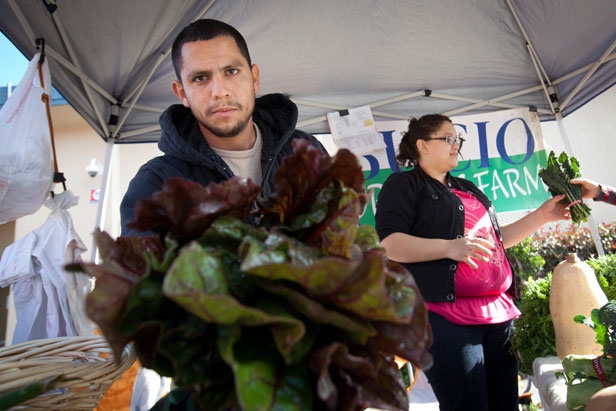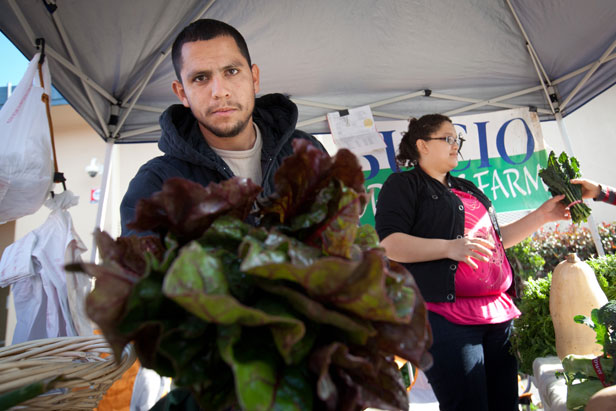 Rigoberto Bucio, 25, selling his own organic produce at the North Oakland, Calif. farmer markets. Photos: Bart Nagel
Rigoberto Bucio, 25, selling his own organic produce at the North Oakland, Calif. farmer markets. Photos: Bart Nagel
The strawberries, purchased in November, in a rainy parking lot behind a community clinic, feel like they’ve traveled in time from summer to here. Out of season, strawberries usually taste like rainwater. These have a taste that is sharp and unexpected.
The North Oakland farmers market is almost deserted — it’s a new one, just getting off the ground. The people here selling their wares look soggy and wan and not especially thrilled to be here. Nor does the wet goat that a couple in rainproof anoraks are trying to coax onto a milking platform.
But Rigoberto Bucio, arms folded, flanked by an army of beets, carrots, chilies, chard, kale, and baskets of the surprisingly sweet strawberries, surveys the scene with equanimity. He’s encountered all kinds of weather working in the fields. At least here he’s standing under a white plastic tent and selling what he grew himself, at Bucio Farm.
Bucio got into farming out of a certain pragmatism. “It’s the best thing that I know how to do,” he says. “And I don’t want to work in a closed space. And I love it when people tell me my produce is very good.”
Although he looks older, until he cracks one of his shy smiles, he is just 25 years old — astonishingly young compared to the average age of U.S. farmers, which is 55. He is also in a distinct minority: not only does he farm organically, but only 2.5 percent of all U.S. farm operators are Latino (or Hispanic, as the USDA’s 2007 Census of Agriculture records it [PDF]).
Bucio is one of a growing number of young migrant workers who, thanks in part to changes in the Farm Bill that freed up funding to train and otherwise assist beginning farmers, are no longer making pennies per bucket picked but working for themselves, running CSAs, and introducing new blood into American farming.
Bucio is still getting used to the changes that this occupational switch involves. As a farmworker, he was part of a class of people that is culturally invisible in America — abstract because to think of it too closely makes people feel uncomfortable. Organic farm work is arguably healthier than conventional farm work, but it’s still work that not many people fantasize about doing. Now, he’s something else, the Farmer — that archetype revered by many Americans. More so than a politician or a lawyer or a plumber or an executive director of marketing, the small-time farmer is America as America would like to see itself.
Pick your poison
California supplies more than half of the country’s produce, and unlike corn and soy, fruits and vegetables have proved one of the most difficult crops to mechanize.
The Salinas Valley produces a lot of cool-season, high-value crops like strawberries, and these attract a largely low-skilled and low-paid labor force. Over a quarter of the population of the surrounding county works in agriculture or processing, but the area itself is a food desert — food is shipped out as soon as it is picked or processed, and is often too expensive for the people who work farming it. (Look for the next story in the California series, on te food desert in the middle of the Central Valley.)
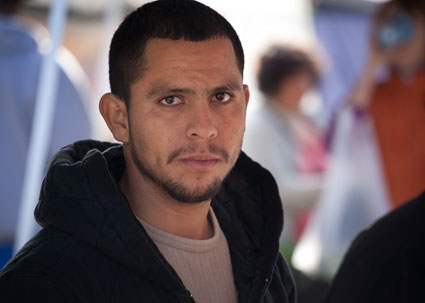 Rigoberto Bucio.Bucio dropped out of middle school in Mexico to come to the States and work in the strawberry fields of California. Americans eat 75 percent more strawberries than they did 20 years ago, but the plant itself has remained stubbornly resistant to attempts to mechanize its production. It wants to be picked by actual people. The closest thing to industrialization the crop has seen is the conveyor-belt system that radiates out from the center of the field to the edge, so that workers don’t have to carry the full flats of berries to the trucks parked nearby.
Rigoberto Bucio.Bucio dropped out of middle school in Mexico to come to the States and work in the strawberry fields of California. Americans eat 75 percent more strawberries than they did 20 years ago, but the plant itself has remained stubbornly resistant to attempts to mechanize its production. It wants to be picked by actual people. The closest thing to industrialization the crop has seen is the conveyor-belt system that radiates out from the center of the field to the edge, so that workers don’t have to carry the full flats of berries to the trucks parked nearby.
As a farmworker, Bucio only worked on organic farms. “Because I like to eat the strawberries as I harvest them” is what he says, but it’s also well known by farmworkers that the people most at risk from pesticides are not people buying their produce at the supermarket, but the person working in a recently sprayed field.
In the last 10 years, Bucio has learned a lot about strawberry plants, and almost nothing of English. He hasn’t really needed to — in California, the language of farming is Spanish. As the number of overall farms in Monterey County, the area around Salinas, has dropped due to consolidation and development, the number of Latino farmers has increased by 70 percent since the late ‘90s, according to the USDA census.
Bucio would seem like an unlikely candidate for the tangle of regulatory obligation, self-promotion, and epic paperwork that is modern organic farming. But he’s ambitious, and he was lucky enough to get help from Agriculture and Land-Based Training Association (ALBA), a business incubator that works with people — mostly Latino, mostly low-income — to set them up as independent organic farmers. ALBA is funded by the EPA, the USDA, a patchwork of nonprofits and corporations, and through the sale of the produce grown by its members, under the name ALBA Organics. Four out of five students enrolled in ALBA’s free six-month training program make $32,000 or less in yearly income.
To get into ALBA’s program, Bucio had to fill out a five-page application that asked, in English and Spanish, questions such as “Can you operate a tractor? Can you weld? Can you read and write? What would you plant if you could plant anything?” Classes at ALBA cover not only farming, but how to navigate the business culture around it: How to start up a CSA. How to sell to restaurants. How a certain kind of customer is more likely to buy produce if it’s displayed in little wicker baskets.
“There’s a whole spectrum of knowledge,” says Gary Peterson, deputy director of ALBA. “There’s harvest. Post-harvest handling and packing. When should you harvest that bok choy? In the morning? In the afternoon? If you’re packing a box for the wholesale market, what is it supposed to look like? Is it going to make a person at a market take the box, or just reject it outright?”
During the course, each student has to write a business plan, and present it before a panel of farmers in what Peterson describes as “American Idol for small-time farmers.”
The land that Bucio farms is part of an 110-acre spread that is shared by about 40 ALBA farmers — a parcel bought originally from a local judge for a program that was part of Lyndon Johnson’s War on Poverty, defunded during the Reagan administration, and ultimately taken over by the organization that became ALBA.
Seen from the air, the ALBA parcel looks quirky. Surrounded by a plain of flat, monotonous rectangles, the land is a patchwork of more than 50 crops flanked by hedgerows — a technique that most farmers don’t use anymore, because they take up farming real estate, but which provide habitat for insects that can bo
ost pollination.
Managing an area farmed by novices is complex. It’s a tricky business to keep them from accidentally flooding each others’ land and up to date on the paperwork for the 11-plus different regulatory agencies they need to be in compliance with — including (but not limited to) the water board, the agricultural commissioner, and the California department of food and agriculture.
Paperwork, it’s emphasized, is critical. Not all of the farmers can read and write, in Spanish or English, but paperwork still needs to get done, even if through an intermediary. Once, a farmer who couldn’t produce the paper trail to prove that his stakes weren’t treated with pesticide had to pull them all up. One of the first homework assignments is to go down to the Monterey County office and register as a farmer.
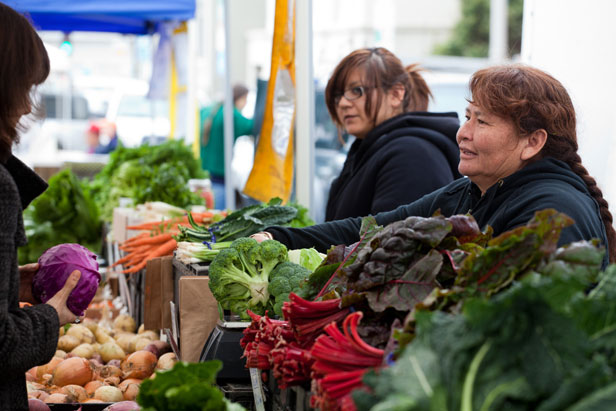 Maria Catalan (right) is one of ALBA’s success stories. She sells at 13 farmers markets.
Maria Catalan (right) is one of ALBA’s success stories. She sells at 13 farmers markets.
Ground breaker
Maria Catalan, one of ALBA’s greatest success stories, once started like Bucio, at a few farmers markets. Now Catalan Farms cultivates 14 acres and sells at 13 farmers markets as well as to high-end restaurants in San Francisco.
A few times, Catalan has been invited to dinner at these restaurants. “It’s sometimes very luxurious and it’s free, but at one of the restaurants they gave me a small tortilla — very small. And it had zucchini and it was so small and I thought, ‘This is zucchini?’ In my house, when I make zucchini, I make a huge pot of them,” she tells me, through a translator. “The only thing that I like about the restaurants is the wine.”
When she crossed the border into the United States 22 years ago, she became a third-generation migrant farmworker — an occupation that began when her grandparents first crossed the border to pick vegetables in Texas.
Catalan has the air of toughness you might expect from someone who once worked for as many as 12 different companies in a single year, cultivating broccoli, spinach, parsley, and anything else that needed cultivating.
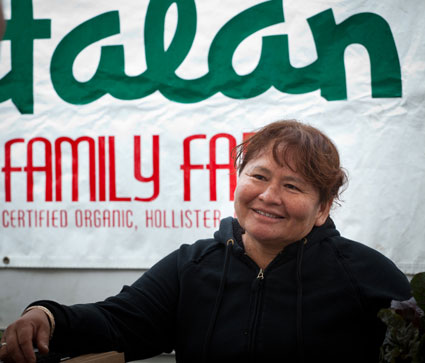 Maria Catalan.“When you start working as an immigrant, you become a number instead of a person,” she says. It is an exponentially more difficult job for women, too.
Maria Catalan.“When you start working as an immigrant, you become a number instead of a person,” she says. It is an exponentially more difficult job for women, too.
These days, when someone accidentally calls Catalan a farmworker, she corrects them kindly but firmly. A farmworker, in her opinion, is someone who doesn’t have control over their own life. She wants to make it perfectly clear that she is not that person anymore.
The people on her farm, she says, work without supervisors. This management style owes something to her years of being supervised, but it also has more than a little to do with the fact that most of her staff is related to her. The attrition rate at ALBA can be high at times — the training may be free, but farm work doesn’t pay well, and often people who would be taking classes are financially supporting other family members.
Several people in Catalan’s family, including all of her siblings, wanted to become farmers themselves but dropped out before the six months of classes were finished. Catalan had a boyfriend while she was in the program who was helping her with the bills, though he left in a fit of pique after he realized that the classes were making her less inclined to listen to his farming advice.
Catalan’s farming style is a mixture of what she learned at ALBA, and her family’s own folklore and hard-won knowledge about how to make plants grow. She grows varieties of corn that are mostly grown in Mexico. But she also grows kale, which she’d never seen before she came to California. She decides when to plant by following the phases of the moon, because that’s the way that her family has always done it, and because, in her opinion, it makes the crops grow better.
Catalan grows organically because that’s how her grandfather, who once owned a farm in Guerrero, Mexico, grew his peanuts, corn, cotton, beans, chilies, and sesame seeds. Everyone in Mexico did back then.
“Organic,” Catalan says, “That’s our farming. We know how to do that already.”
Loan rangers
It’s been said that 90 percent of being a farmer is figuring out how to get your crops to the people that eat them without going completely broke. Catalan credits her success to working, relentlessly, to get a spot at the Berkeley farmers market. Bucio believes it’s about working hard, but isn’t sure if he’s going to be a success.
ALBA’s funding has increased, and beginning and low-income farmers now have access to a few loans and benefits like conservation incentives that were previously only available only to large farmers. Loans, such as they are, exist in very low amounts. In some ways, this is just as well, says Peterson, as micro-loans prevent beginning farmers from getting into more debt than they can handle.
It’s unlikely that any of these farmers will ever own their own land. For all of our image of farmers as rugged, property-owning American individualists, over 40 percent of American farmland is rented [PDF]. And California has some of the most expensive farmland in the world — the going rate to rent an acre near where Bucio farms ranges from $1,300 to $2,000 for an acre, for a year. Since this is his first year, Bucio is paying $250 per acre, per year, to ALBA. Each year, that rent will increase slightly.
Ana and Eleazar Juarez, who graduated from the program seven years ago, are now paying full rent on the land for their farm — Rio De Parras Organic. They’re counted as one of the program’s successes — Eleazar now farms full-time and Ana, who worked full-time as the stock-room manager at the Salinas Target while she was taking classes at ALBA, now only works at Target during the winters.
Seeding the Salinas Valley with small farmers is another one of ALBA’s eventual goals. Most organic farmers don’t look like Bucio and Catalan, and organic food, rightly or wrongly, is seen as unaffordable by agricultural workers in the valley. Would those workers buy more fruits and vegetables if the farmers looked like them? Could those people who farm on the 110 acres make a good living selling to the people in their own community?
They’d like to. ALBA just carried out a strategic planning process with the farmers that it has been training. Ana Juarez was one of the people at the table. How, ALBA wanted to know, would its success be measured? When you’re training people for one of the hardest, least well-paying gigs in America, what does success look like?
The answer was this. The farmers got together and decided that they would know they were successful when they had enough to give away — to the food bank, to the community. Once they’re able to give back to Salinas, they’ll know that they’ve arrived.

